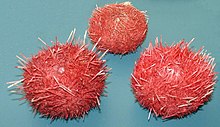Sterechinus neumayeri
| Sterechinus neumayeri | |
|---|---|
 |
|
| Sterechinus neumayeri | |
| Scientific classification | |
| Kingdom: | Animalia |
| Phylum: | Echinodermata |
| Class: | Echinoidea |
| Order: | Echinoida |
| Family: | Echinidae |
| Genus: | Sterechinus |
| Species: | S. neumayeri |
| Binomial name | |
|
Sterechinus neumayeri (Meissner, 1900) |
|
| Synonyms | |
|
Sterechinus neumayer |
|
Sterechinus neumayer
Sterechinus neumayeri, the Antarctic sea urchin, is a species of sea urchin in the family Echinidae. It is found living on the seabed in the waters around Antarctica. It has been used as a model organism in the fields of reproductive biology, embryology, ecology, physiology and toxicology.
The of the Antarctic sea urchin and several other urchins found in the circumpolar region was examined in order to assess their phylogenetic relationships. It was found that Sterechinus neumayeri was most closely related to Paracentrotus lividus and Loxechinus albus, both of which are found in the southernmost part of South America. The divergence of the 3 species began 35 to 25 million years ago, which coincides with the period at which Antarctica became separated from South America.
The Antarctic sea urchin ranges in color from bright red to dull purple and can grow to 5 centimetres (2.0 in) in diameter. The test is globular with vertical rows of long, strong, white-tipped spines between which there is a dense covering of smaller spines and vertical rows of tube feet. The spines and tube feet enable the animal to move across the ground. There are often fragments of red algae adhering to the spines.
The Antarctic sea urchin is found in circumpolar waters including the Southern Ocean, the Balleny Islands, South Georgia and the South Sandwich Islands, Terra Nova Bay and Victoria Land. Most of the specimens found have been in water down to a depth of about 250 metres (820 ft).
The Antarctic sea urchin largely feeds on diatoms and other algae. It also consumes foraminiferans, amphipods, bryozoans, hydrozoans, polychaete worms and sponges and also seal faeces when available.
...
Wikipedia
